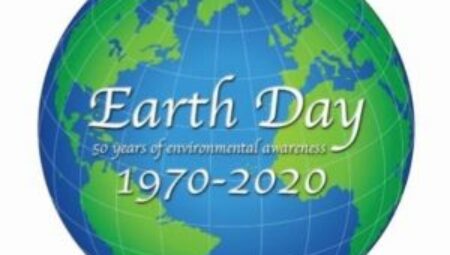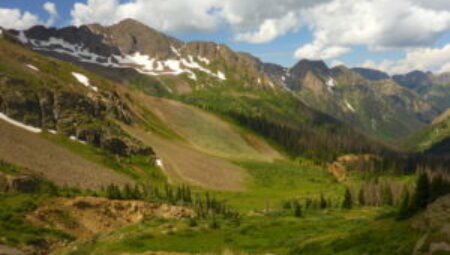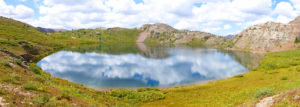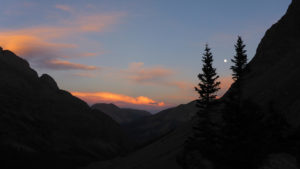The rugged, rewarding work of wilderness stewards
By Harry Bellow
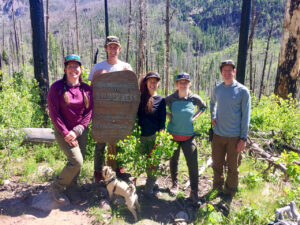 Traveling through the wilderness of the San Juan Mountains, you might not have seen us. We are an elusive bunch.
Traveling through the wilderness of the San Juan Mountains, you might not have seen us. We are an elusive bunch.
Oftentimes, our work leads us off trail, bushwhacking to high alpine lakes in the shadows of towering peaks. Odds are you have stumbled across our work at some point during your trips into the wilderness. Our work is often invisible unless you know what to look for: clear trails, litter-free campsites and the disappearance of illegal campsites. The life of a wilderness steward is not easy, but the rewarding nature of the work draws one into a vast array of uncomfortable situations.
Funded with donations to San Juan Mountains Association’s Weminuche Wilderness Stewardship Fund, the task of the Wilderness Stewardship Team is to preserve, protect, monitor and educate people about wilderness principles. Our office is the wilderness areas around Durango, some of the most extreme terrain in the Lower 48.
On a typical week, we arrive at the Public Lands Center at 7 a.m. with backpacks filled with four days’ worth of supplies. We gather tools and team equipment, such as radios, crosscut saws, Pulaskis and shovels. Our drive out to the wilderness can take anywhere from 30 minutes to a whopping five hours. Sometimes, it is impossible to get all the way to a trailhead as the roads can be extreme in the rugged country. Upon arrival, the team suits up and begins work.
As we enter the wilderness area, we mark down the time and begin to count people we see. The data we collect about usage goes to classify the area in terms of impact. Pristine areas are relatively untouched by humans while semi-pristine areas are impacted by constant visitor use.
While we collect this data, we are monitoring campsites as well. Led by Asia Pfiefer, wilderness monitoring lead of the San Juan National Forest, the team is given GPS coordinates of existing campsites in the area. We find all of these campsites, survey them, pick up any litter and destroy them if they are illegal or have not been used for many seasons.
Commonly, we find aluminum foil in the fire rings, toilet paper in the bushes and forgotten frying pans. Most often, campsites are found along the trails and near a water source. Camping too close to a water source, less than 100 feet, dissuades wildlife from using it.
As we wander through the wilderness, we also complete trail work and make visitor contacts. Our mission is to protect the wilderness character. By clearing trails, we funnel the impact of visitors into a narrow area leaving most of the wilderness in its pristine state. We inform visitors about ways to minimize their impact so the wilderness character can be preserved for generations to come. All the while, mountains and the sounds of wind, birds and insects surround us.
As the sun sets, our work is finished. We often cook dinner, jump into lakes and sleep like the rocks surrounding us. I prefer to get in a nature run before the light fades. I am rewarded with the sights of deer and elk bounding away from me, and I am reminded of my visitor status. The sights I am privileged to see and the clean mountain air remind me of why I do what I do.
Harry Bellow works with San Juan Mountains Association as a wilderness steward.
- Published in Education, Stewardship
The bright sides to the problem of beetle-killed trees
by MK Gunn
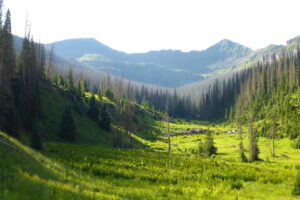 Deep in the Weminuche Wilderness there is a trail that dead ends at the head of a verdant valley crowned by majestic mountains. My two dogs and I wandered up there in August of 2016. After seven miles on a major trail, we turned onto a faint trail. We tromped up a sunny meadow to the edge of the woods. The forest was thick there. Engelmann spruce and subalpine fir tangled amongst the occasional southwestern white pine. These skyscrapers formed the canopy. Down below, deciduous bushes mingled with tall summer wildflowers. Larkspur, monkshood, and cow parsnip were over my head. Ragwort, columbine, and bittercress filled in below. There is a reason why this area was so laden with wildflowers. Almost all the towering spruce trees were dead.
Deep in the Weminuche Wilderness there is a trail that dead ends at the head of a verdant valley crowned by majestic mountains. My two dogs and I wandered up there in August of 2016. After seven miles on a major trail, we turned onto a faint trail. We tromped up a sunny meadow to the edge of the woods. The forest was thick there. Engelmann spruce and subalpine fir tangled amongst the occasional southwestern white pine. These skyscrapers formed the canopy. Down below, deciduous bushes mingled with tall summer wildflowers. Larkspur, monkshood, and cow parsnip were over my head. Ragwort, columbine, and bittercress filled in below. There is a reason why this area was so laden with wildflowers. Almost all the towering spruce trees were dead.
These trees were eaten from the inside out, suffocated and dehydrated by tiny spruce beetles, and had been dead for ten years. The dead trees had begun to fall, opening up the canopy to allow more sunlight and awaken the long dormant wildflower seeds.
The fallen trees complicated travel. After the meadow, the trail was hard to see among the fresh deadfall. I danced under, over, and around three fallen trees within the first ten feet. They rested at varying heights and their mischievous branches grabbed at me. My overnight pack made the choreography harder. My dogs wondered why I was always so slow.
 One large tree had fallen higher than my head but its branches insisted that I continue my awkward dance while tiptoeing on stepping stones in a small stream. Other places offered no view of my footing. I stepped blindly as I parted wildflowers. Some might wish for a machete but I was mesmerized by the density of the foliage. No humans had been up that way in weeks or maybe even longer.
One large tree had fallen higher than my head but its branches insisted that I continue my awkward dance while tiptoeing on stepping stones in a small stream. Other places offered no view of my footing. I stepped blindly as I parted wildflowers. Some might wish for a machete but I was mesmerized by the density of the foliage. No humans had been up that way in weeks or maybe even longer.
Not only had the beetle-killed trees assisted the proliferation of pretty petals, but the first two miles of difficult trail hemmed in another six miles of vast valley meadows intermingled with flowing streams. This prime and protected habitat supports a myriad of wildlife. In one meadow, I encountered a massive herd of cow elk with their spotted calves and startled a young mountain lion that was stalking them. The dead trees created an island where wild creatures carried on their lives as nature intended.
Spruce beetles and other tree-eating bugs are part of nature. In an ecosystem with fewer beetles and healthier trees, trees can actually push the beetles out with sap – known as “pitching out”. But nature is out of sync right now and the current beetle infestations in the western US are exasperated by drought and warmer temperatures. Longer summers allow local spruce beetles to complete two reproductive cycles each year instead of just one and winter temperatures haven’t been cold enough to kill the beetles. On top of that, drought provides less water to the trees so they can’t pitch out the beetles.
Perhaps you are wondering what you can do to help. We can all start by being patient. The COVID-19 pandemic has reduced the number of trail crews and delayed start dates. This means that some of your favorite trails might not be cleared this year making it difficult to recreate. Some trails may be impassable to stock. Fortunately, in a collaboration with the San Juan National Forest, San Juan Mountains Association will help manage a new backcountry ranger crew made possible by generous donations from the local community. (See the April 2020 “Stewards of the Land Column”.)
Another way that you can help is simply by spreading the word. The space beetles aren’t going away. They are munching their way west through the San Juan National Forest. Yes, it can be depressing to see these huge trees die and drastically change some of our favorite places. Yes, it will mean more blocked trails. But it also means more wildflowers and secluded wildlife habitat. Now more than ever, we need to see the bright side of things.
MK Gunn works for the San Juan Mountains Association. In her free time, she seeks out remote places that may or may not contain trails. Email her at MK@sjma.org.
SJMA Seeks to Inspire Public Lands Conservation
By Lexie Stetson-Lee
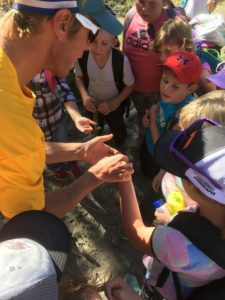 San Juan Mountains Association (SJMA) is developing a pipeline of conservation education programs to connect the local community with their public lands. SJMA has long provided interpretive programs as a partner of the U.S. Forest Service, serving up glacial geology tours, edible plant hikes and volunteer crew training for adults with a passion for conservation. And
San Juan Mountains Association (SJMA) is developing a pipeline of conservation education programs to connect the local community with their public lands. SJMA has long provided interpretive programs as a partner of the U.S. Forest Service, serving up glacial geology tours, edible plant hikes and volunteer crew training for adults with a passion for conservation. And
now, after the organization’s merger with Durango Nature Studies, we are able to pair youth education, from preschool to high school, with stewardship of local land.
This pipeline of programs is rooted in the idea that consistent, repeated outdoor experiences over one’s lifetime can have a transformative effect. A transformative effect on self-efficacy levels, technical skills, mental health and a sense of belonging. A transformative effect on how we react to, and relate to those using public lands differently than we do. A transformative effect on the local landscape as we decide to respect and steward our public lands.
You know the ingredients: backyard exploration, cultural stories, time by a creek, experience working with animals and agriculture, chopping wood, hiking the blackened Hermosa Creek Trail, and looking for fish in the Highland Mary Lakes. These are the building blocks for an ethic of stewardship. Developing good stewards of the land is a process—it takes time and effort.
Outdoor education has the power to do this work, especially in small, myriad ways. The other day, my four-year-old daughter shrieked: “Harold!” She named an ant found on the sagebrush hill behind our house. “Airwld.” Repeated my two-year-old son after her. Monkey see, monkey do. Small, consistent trips outside serve as medicine during this time of stay-at-home anxiety, in addition to providing educational opportunities. Lately, in our household, we’ve learned about Wilderness designation, local watersheds, and the Woolly Apple Aphid. I treasure outside time with my own children as it reasserts that they will have a connection to nature, and if not an interest in, at least a willingness to learn about life interwoven with the land. Their future will depend on our collective ability to live in harmony with the natural world. Southwestern Colorado’s identity, heritage, quality of life and economic well-being all stem from our connections to the spectacular public lands that surround us. I hope that through repeated connections to nature, my own children will be given a voice in these issues.
Public lands stewardship is a recognition of our collective responsibility. A timely idea as we process the COVID-19 pandemic and our response to it. Seemingly, our collective responsibility for stewarding public lands is even more poignant—even more promising with a robust educational infrastructure. The small choices we make now, including educating ourselves and our community, are key steps towards a healthy land use future.
With Colorado Public Lands Day upon us, on May 16th , SJMA encourages everyone to recognize and celebrate the incredible access we have to open space and the outdoor education opportunities available in our region. In honor of Colorado Public Lands Day, SJMA is hosting a Facebook Live teach-in on the “Watersheds of the Weminuche Wilderness” at 10:00 AM on Thursday, May 14th . Join us to learn how the spectacular Weminuche Wilderness contains some of the West’s most important watersheds. We’re hopeful that your engagement will spur more interest in the land we all use and love.
- Published in Education
Earth Day 2020: A Great Day to Explore and Protect the San Juans
By Brent Schoradt, SJMA Executive Director
 Today is the 50th anniversary of the first Earth Day. Fifty years ago, on April 22, 1970, more than 20 million Americans joined together to demand greater protections for our forests, watersheds, and air. This collective action helped lead to the passage of America’s bedrock environmental laws. Within months, President Nixon signed the Clean Air Act, and the Clean Water Act was soon to follow in 1972. Since the first Earth Day, Congress has added nearly 100 million acres to the National Wilderness Preservation System, including the Weminuche Wilderness in 1975.
Today is the 50th anniversary of the first Earth Day. Fifty years ago, on April 22, 1970, more than 20 million Americans joined together to demand greater protections for our forests, watersheds, and air. This collective action helped lead to the passage of America’s bedrock environmental laws. Within months, President Nixon signed the Clean Air Act, and the Clean Water Act was soon to follow in 1972. Since the first Earth Day, Congress has added nearly 100 million acres to the National Wilderness Preservation System, including the Weminuche Wilderness in 1975.
Earth Day is a great reminder that, in our democracy, ordinary citizens can help determine the fate of our most treasured natural resources, and the Earth itself. This is the ethos of the San Juan Mountains Association. Since its founding in 1988, SJMA has empowered the public to explore, learn about, and protect the spectacular public lands of Southwest Colorado.
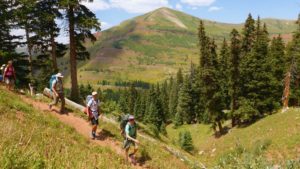 In celebration of Earth Day, SJMA encourages everyone to get outside and enjoy your public lands in a safe and meaningful way. Look around, think of those who came before and left this magnificent natural legacy in Southwest Colorado. Think of what you can do to inspire and empower the next generation to care for our public lands and pass on a legacy of conservation through the ages.
In celebration of Earth Day, SJMA encourages everyone to get outside and enjoy your public lands in a safe and meaningful way. Look around, think of those who came before and left this magnificent natural legacy in Southwest Colorado. Think of what you can do to inspire and empower the next generation to care for our public lands and pass on a legacy of conservation through the ages.
This year, SJMA merged with Durango Nature Studies in our quest to build a sustaining conservation ethic in Southwest Colorado. Our goal is simple: to inspire the next generation of land stewards through science-based outdoor education.
We all know that many folks are unable to donate right now. If you are able to donate today, you have the power to give on behalf of those who cannot. You can stand up for our public lands and help our entire community build a conservation ethic that will stand the test of time. Your donations make a difference and we sincerely thank you for contributing.
Many of the organizers and participants of the original Earth Day, were young people inspired to act during challenging times. Your donation today will help us inspire the next generation to stand up for our public lands and face the unprecedented challenges that await them.
Thanks to a generous grant from the Payroll Department, all donations to SJMA during this difficult time will be matched, up to $7,000, doubling your impact. Moreover, all donations of $50 or more will receive a free “Wild for the Weminuche Wilderness” t-shirt. What a great way to get kids outdoors and show your support for our local public lands.
Thank you for standing with SJMA on this Earth Day. Your support means the world to us.
- Published in Nature, News, Uncategorized
Wilderness Efforts in time of Covid
by David Taft, Conservation Director, San Juan Mountains Association
As one of Durango’s longest running public lands education and stewardship organizations, San Juan Mountains Association has plenty of experience connecting folks with the outdoors and confronting challenges in the backcountry. However, just like everyone else, we are caught in the midst of the ongoing public health situation. We’re currently observing how it relates to our local public lands and the San Juans community, as well as figuring out how we will approach this season. We have been in close communications with our agency partners, fellow conservation organizations, and healthcare specialists to ensure that we can continue pursuing our mission of caring for our local public lands, while protecting the health of our staff and supporters.
This season we have planned on upping our efforts in the Weminuche Wilderness, and we continue working hard to ensure that these plans can go forward. This is especially important as people continue to retreat to the local mountains for their social distance, a trend likely to continue as weather warms and trails dry. In a collaborative effort with the San Juan National Forest, we will help manage a new San Juan Ranger crew thanks to generous donations from the local community. This crew will be backpacking through heavy use areas, documenting and maintaining trail conditions, restoring heavily impacted areas, engaging with the public (according to CDC guidelines), and ensuring that the SJNF has the information they need to make informed management decisions. We will be providing reports from the field over the course of the season so that we can all keep an eye on their progress.
While in-person volunteer events are off the table in the near term, there are still ways to get involved. Sign up for a webinar (we are hosting a Colorado Public Lands Day crosscut saw Zoom course!), stay informed about future volunteer outings through our E-News at sjma.org, and share your stories and photos to stay positive. We encourage everyone looking to stay excited about our magnificent local public lands by sending in a short write up along with photos of a memorable trip to the San Juans. You can send these to us at our instagram @sjma_co, Facebook, or info@sjma.org.
As always, we will continue to offer visitor information for local public lands, and our staff will do their best to provide the clearest up to date guidance on trails, access, facilities, and regulations.
Thank you, be safe, be healthy, stay close to home.
- Published in Education, Hiking, volunteers
Southwest Colorado Stands up for Public Lands
By Brent Schoradt, SJMA Executive Director
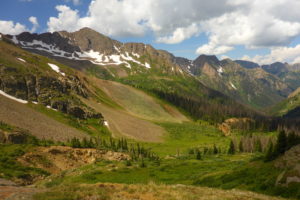 Open skies, big mountains, wild rivers, great trails, and great people. We live in a vibrant, thriving community surrounded by spectacular public lands.
Open skies, big mountains, wild rivers, great trails, and great people. We live in a vibrant, thriving community surrounded by spectacular public lands.
We are drawn to Southwest Colorado for the easy access to unmatched outdoor recreation and proximity to wild open spaces. The word is out. Southwest Colorado has experienced immense growth in tourism and population over the past several decades. Our amazing landscape attracts thousands of visitors and new residents, who come to enjoy the scenery and get outdoors in the San Juan Mountains. By 2050, Archuleta, Dolores, La Plata, Montezuma and San Juan counties are collectively projected to experience a whopping 78% increase in population.
Our public lands are the backbone of our local economy and Colorado’s $62 billion outdoor recreation economy. Our forests and watersheds are the goose that lays the golden egg.
Unfortunately, public lands face mounting threats. Increasing numbers of visitors, declining wildlife populations, beetle infestations, drought, and catastrophic wildfire all threaten the health and sustainability of our forests and watersheds.
These are immense challenges. The question is: what can ordinary citizens do to help safeguard our public lands? San Juan Mountains Association (SJMA) seeks to empower the local community to give back to public lands in the face of mounting challenges. We believe in a vision of shared stewardship, where local volunteers work hand-in-hand with land managers to create a new model of public lands conservation based on citizen engagement.
We all have a role to play. SJMA invites every citizen, every town, every business, every school to join us as we embark on three key initiatives: (i) engage in public lands stewardship projects that improve conditions on the ground, (ii) educate the public on how to responsibly visit public lands without harming key watersheds and forests, and (iii) foster a conservation ethic that will stand the test of time by connecting youth of all ages to the outdoors through science-based education.
Here are two easy ways to join us this summer:
Become a San Juan Ranger: This summer, SJMA’s volunteer San Juan Rangers will educate wilderness visitors on proper “Leave No-Trace” practices, improve trail access, and conduct important on-the-ground restoration projects in the Weminuche Wilderness. The San Juan Rangers are ordinary folks willing to stand up for public lands by donating their time and energy to wilderness stewardship. Apply to be a San Juan Ranger and join us as we give back to the Weminuche.
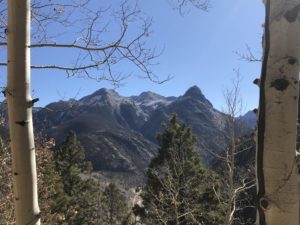
Send a Kid to Summer Camp: This year, SJMA and Durango Nature Studies merged to create a comprehensive education program that connects youth of all ages to public lands through hands-on science education. SJMA is proud to continue the Durango Nature Studies tradition of providing enriching and educational summer camps for youth. Encourage your kids to get outdoors this summer by sending them to an SJMA summer camp, or sponsor a camp spot and invest in the next generation of land stewards.
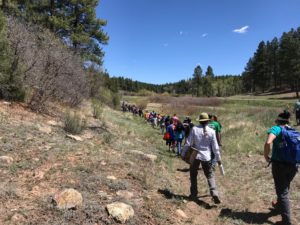
Together, we can show the way and make Southwest Colorado a model community for public lands stewardship.
- Published in Uncategorized
Where the Wild Things Are
By MK Gunn
As I laced up my hiking shoes at my sister’s house in the East Bay area of California, my five-year old niece came running up to me. “MK!” she exclaimed, her dark eyes sparkling and curly hair bouncing. “If you see any animal tracks, will you take a picture for me?!”
I was elated by her interest in nature and told her that I certainly would! Yet I doubted there would be any animal tracks. Then I set off for the trails of Joaquin Miller Park. It was Sunday and, as expected, any critter tracks from the night before had already been covered by tracks from hikers, runners, and mountain bikers. The wild animals around here certainly knew to steer clear of the barrage of weekend recreationists. I barely even heard a few birds on my two hour jaunt.
The interaction with my niece got me thinking about just how different the lives of wild animals are in Colorado compared to areas heavily populated by humans. Since wild animals aren’t often seen, it can be easy to forget about their roles in nature and that their ancestors were here long before most of ours.
Spying wild animal tracks is a daily occurrence in Durango. Many wild animals make their homes on the edge of town and then wander past my house a mere mile from downtown. These include deer, raccoons, skunks, bears, coyotes, gray foxes, kit foxes, squirrels, and the occasional mountain lion. Many birds live right in town such as crows, finches, sparrows, juncos, magpies, and owls.
We are very fortunate in Southwest Colorado to have the state’s largest Wilderness area. (See my column from November 2019 for more about designated Wilderness). The Weminuche Wilderness contains 499,771 acres of roadless area. Joaquin Miller Park and adjacent Redwood Regional Park might seem big when I am on the trails, but their combined area is only 2,330 acres and there are occasional roads running through. Overall, East Bay parks cover a patchwork totaling just 120,000 acres that serves 2.5 million residents! The population in the counties surrounding the Weminuche Wilderness adds up to just 72,490 people – a mere 3% of the East Bay population.
Wild animals do live in areas heavily populated by humans but these animals spend much of their lives sneaking around to avoid humans. Redwood Regional Park is home to surreptitious deer, coyotes, raccoons, rabbits, squirrels and even the rare golden eagle and Alameda striped racer (a type of snake). As humans have encroached further and further on their natural habitats, they have had to adapt in order to survive. Undoubtedly there are far fewer wild animals in these places than there were 100 years ago. Not only have populations dwindled, but diversity of species has also greatly declined.
But there are many places in Colorado where humans are so rare that wild animals don’t even know to be afraid of us. A few years ago, I was on a newly cut section of the Continental Divide Trail. The trail was so new that the pikas were barely cautious when they saw me. As I stood there, they would run up within inches to get a better look at me and then run away. But they didn’t hide. They were so curious and cute! I’ve had similar experiences with pikas in remote corners of the Wind River mountain range in Wyoming. Once, a pika even licked my salty leg while I was taking a rest on a mountainside. Then it tried to nibble on me! There are wild animals living in Colorado that have never even seen a human. They live their entire lives deep in the wilderness.
So, the next time you see a wild animal – even if it’s a common mouse, deer, or magpie – remember how fortunate we are to have such a diversity of wildlife here in Southwest Colorado. But we are all responsible to make sure that wild animals are here for future generations. Please, help us all by doing your part:
- Properly store your trash and toxic chemicals – these can kill wildlife.
- Don’t feed wild animals – they will become habituated to humans and may become subject to starvation or poaching.
- Keep dogs on leash or within sight and under voice control. Don’t let them chase animals.
- Don’t taunt or scare wildlife unless they are clearly threatening you.
- Educate those around you as to what is best for wild animals.
- Remember, the wild is their home. We humans are just visiting!
MK Gunn enjoys sneaking quietly around the nearly 3 million acres of public land in southwest Colorado hoping that only pikas try to nibble on her. Contact her at MK@sjma.org.
Community partnerships paramount for our public lands
By MK Gunn

“San Juan National Forest employees came out on their day off to assist SJMA staff and volunteers in a trash clean-up project on Colorado Public Lands Day.” Photo credit: Kathe Hayes
’Tis the season where most of us take time for year-end reflection and are getting excited about the upcoming year.
For me, this exercise reminds me of how grateful I am for this community and how we all work together to care for our public lands. Even though I have been known to disappear for days with no one else but me, I understand the importance of community and having so many people working toward the same conservation goals as me. Even the most introverted of introverts can’t get much accomplished without occasionally enlisting help from other people.
Think about it: What would you be able to accomplish without your community members? If you live on a farm, maybe you can produce your own food, but where did you get that tractor? You can claim self-sufficiency and commute everywhere by bike swearing that you don’t need the local gas stations, but you still need bike tires, chain lube and brake pads. You can collect all the firewood you need to heat your house, but what’s fueling your water heater? And what if you just need someone to listen and give you a hug? I’m sure every one of you has an arsenal of local supporters that help make your life easier and more enjoyable.
Our local public lands also have a huge family of support. In 2019, the San Juan Mountains Association collaborated with a number of local partners. Some have been with us since the beginning (like the San Juan National Forest), and others are new (Durango Outdoor Exchange), but every one brings something important to the table as we work toward a common goal – empowering the public to explore, learn about and protect our local wilderness areas and public lands.
I wish I could list all of our community partners, but then this article would take up pages. Our supporters at The Durango Herald and Cortez Journal graciously offer us a column each month, not pages. Here are just a few highlights of SJMA’s collaborations with local partners in 2019:
- Encouraged more than 4,000 trail users to “Leave No Trace” at the Ice Lakes trailhead thanks to the Outdoor Research Tiny Home, Backcountry Experience and our tireless volunteers
- Co-hosted the seventh annual Forests to Faucets teacher workshop with Mountain Studies Institute, Water Information Program and the Fort Lewis College teacher education department. Sponsors also included the Southwest Water Conservation District, Colorado Water Conservation Board, Durango Education Foundation, Colorado Alliance for Environmental Education and Trout Unlimited 5 Rivers Chapter
- Co-hosted the Hermosa Resilience Project with Trails 2000, Durango Nature Studies, MSI and the San Juan National Forest
- Educated more than 300 locals and tourists about the flora, fauna and geology of the San Juan National Forest thanks to Purgatory Resort
- Raised money for the Weminuche Wilderness and conservation education at our Christmas tree lot thanks to Alpine Bank, San Juan National Forest, Southwest Ag and a long list of individual volunteers. Special thanks to Alpine Bank for its longstanding support of SJMA programming and for being our 2019-2020 corporate partner
- Assisted locals and tourists with selecting a wild Christmas tree as part of the Christmas tree train – a collaboration with Durango & Silverton Narrow Gauge Railroad, Wildfire Adapted Partnership and San Juan National Forest
- Provided hunter information to more than 100 hunters at our hunting booth at the Colorado Parks and Wildlife Durango office
- Hosted a “Share the Trails” poker run with stellar assistance from the BLM Tres Rios Field Office, Creeper Jeepers, Mesa Verde Backcountry Horsemen, Mancos Trails Group and Hoofbeats 4H
- Raised money for the Weminuche Wilderness with a 10k trail run and a chili cook-off thanks to Backcountry Experience, Ska Brewing, Durango Running Club, the city of Durango and a variety of local chili cooks from local nonprofit and for-profit businesses
- Provided visitor information to thousands of locals and tourists at our 14 bookstore locations thanks to support from district and supervisors’ offices throughout the San Juan National Forest and Rio Grande National Forest as well as the Mancos and Silverton visitor centers
- Created a greater awareness of recreation and conservation opportunities on public lands by connecting with young people in Montezuma County thanks to the Montezuma Inspire Coalition and Great Outdoors Colorado
- Raised a glass to wilderness and supporting local businesses on Noel Night at Pine Needle Mountaineering
To find a more complete list and contact information for these wonderful supporters, visit shorturl.at/btvGU.
Last but certainly not least is the community of individuals and families who support public land stewardship through memberships, donations and copious volunteer hours! Thousands of people from all over the country devote their time to caring for the public lands of Southwest Colorado. Best wishes to all of you this holiday season and on through 2020. What an amazing community we have.
MK Gunn is volunteer and education specialist for San Juan Mountains Association. She will be joyously celebrating the season thanks to her favorite community members. Contact her at MK@sjma.org.
Wilderness with A Capital W
By MK Gunn
 What do you think of when you hear the word “wilderness”? Take a minute. Do you think of solitude or camaraderie? Of adventure or relaxation? Of wide open spaces or deep down and forested places? Do you think of wild animals – big or small? Or does the word “wilderness” conjure anything at all? And does it mean anything different with a capital W – Wilderness?
What do you think of when you hear the word “wilderness”? Take a minute. Do you think of solitude or camaraderie? Of adventure or relaxation? Of wide open spaces or deep down and forested places? Do you think of wild animals – big or small? Or does the word “wilderness” conjure anything at all? And does it mean anything different with a capital W – Wilderness?
Southwest Colorado is home to the Weminuche Wilderness – the state’s largest congressionally designated Wilderness (with a capital W) area – and contains 499,771 acres of untrammeled lands. Our home turf also hosts the 158,790 acre South San Juan Wilderness, the 41,496 acre Lizard Head Wilderness, and the 37,236-acre Hermosa Creek Wilderness. That’s 737,293 acres. That’s 1,152 square miles! With all this Wilderness surrounding us, consider what you think you know about Wilderness and read on to see if you know your stuff.
The Wilderness Act was passed by the U.S. congress in 1964 thanks to the tenacity of Howard Zahniser. Sure, a myriad of others contributed to the idea, but Zahniser rewrote the bill an astounding 66 times back in the age of typewriters! He often worked on it for 30 hours straight. He also patiently attended 18 public hearings involving some 16,000 pages of testimony. All of this was to create a federal land designation never before seen in the U.S. Sadly, the stress of this killed Zahniser just months before he could see president Lyndon B. Johnson sign the act into law on September 3, 1964.
A great article on wilderness.org summarizes neatly that “Zahniser pointed out the law was intended to hold our expansionist tendencies at bay: “The nature of our civilization is such as to make wilderness preservation difficult at its best. That is the reason for wilderness legislation.” The main purpose of the Wilderness Act is to leave nature in, well, its natural state.
 So, what can you expect when you venture into a designated Wilderness area? Perhaps most obvious is the lack of motorized and mechanized equipment. Human entry can only be achieved on foot or horseback. There are no roads, motor vehicles, bicycles, or even wheel barrows. (People with disabilities are allowed to enter via wheelchair). Land managers can’t even use chainsaws to clear the trails. Wilderness rangers and partnering non-profit groups use six-foot long cross-cut saws that take two people to use. These saws are remarkably efficient and very quiet. There is some pushback on the above regulations as well as much argument over just what “mechanized” means but that is a topic for another article.
So, what can you expect when you venture into a designated Wilderness area? Perhaps most obvious is the lack of motorized and mechanized equipment. Human entry can only be achieved on foot or horseback. There are no roads, motor vehicles, bicycles, or even wheel barrows. (People with disabilities are allowed to enter via wheelchair). Land managers can’t even use chainsaws to clear the trails. Wilderness rangers and partnering non-profit groups use six-foot long cross-cut saws that take two people to use. These saws are remarkably efficient and very quiet. There is some pushback on the above regulations as well as much argument over just what “mechanized” means but that is a topic for another article.
This lack of motorized equipment not only forces everyone to slow down and smell the flowers; It allows visitors to experience only the sounds of nature. Wildlife is more at ease. One time, my dogs and I were walking so quietly through the Wilderness that as we stepped out of the woods into a clearing, we inadvertently sneaked up on a young mountain lion stalking a herd of cow and calf elk! It was like being inside an episode of Plant Earth. As the Wilderness Act states, Wilderness must have “outstanding opportunities for solitude or a primitive and unconfined type of recreation”.
The Wilderness Act also mandates that there are virtually no permanent manmade structures in designated Wilderness. “A wilderness, in contrast with those areas where man and his works dominate the landscape, is hereby recognized as an area where the earth and its community of life are untrammeled by man, where man himself is a visitor who does not remain.” The word “untrammeled” is often used by Wilderness devotees. Synonyms for “trammel” include drag, hobble, curb, inhibit, impede, obstruct, and encumber. Inside a Wilderness area, you will find no fences, dams, outhouses, weather stations, corrals, or shelters with the exception of some structures that existed before the area became designated Wilderness. If some sort of structure is erected, including a tent, it must be dismantled within 14 days. However, bridges are allowed where deemed necessary for safety. Other structures may be allowed on a case by case basis so long as they are “substantially unnoticeable”. For more clarification on structures in Wilderness and much more, read US Forest Service Manual chapter 2320 entitled Wilderness Management at this link: tinyurl.com/FSM2320-WildernessManagement.
Here’s something else to keep in mind: Many designated Wilderness areas have regulations that go beyond what is stated in the Wilderness Act. For examples, campfires are not allowed in Chicago Basin and the entire Needle Creek drainage within the Weminuche Wilderness. In our four local Wilderness areas, dogs are allowed to be off leash as long as they are under voice control. However, in the Indian Peaks Wilderness west of Boulder, dogs must be on leash at all times. There are sections within other Wilderness areas where dogs are not allowed at all. Group size limits also vary. Be sure to familiarize yourself with the local regulations before visiting any swath of public lands, Wilderness or not. Often, calling the main offices and talking to a real human being is the best way to make sure you have the most up to date information. Responsible use helps keep public lands open and beautiful for future generations.
MK Gunn is Volunteer and Education Specialist for the San Juan Mountains Association. She helps manage a variety of volunteers who spend days out in the Weminuche Wilderness educating visitors. Contact her at MK@sjma.org
Early Hispano History and the Iglesia de San Antonio
By Ruth Lambert
 SJMA has begun a project to study the history of Hispano settlement along the San Juan River in Archuleta County and southeastern LaPlata County. The Hispano contributions are often unrecognized and under-appreciated yet they add a richness to our collective story.
SJMA has begun a project to study the history of Hispano settlement along the San Juan River in Archuleta County and southeastern LaPlata County. The Hispano contributions are often unrecognized and under-appreciated yet they add a richness to our collective story.
Often at old or abandoned small settlements, the church and cemetery are the last remaining elements. In order to learn about the early settlement in the San Juan riverine area, this project studies five Catholic churches at Pagosa Junction, Trujillo, Tiffany, Allison, and the church ruins at Juanita. The project is assembling historical information from church records, genealogical data and interviews with knowledgeable people; collecting historical documents and photographs; and documenting the churches through field recording and photographs.
The communities of Pagosa Junction, Trujillo, and Juanita were established by Hispanos from the Tierra Amarilla and San Luis Valley areas and they developed mercantile stores, post offices, schools, mission Catholic Churches, and cemeteries. With the arrival of the Denver & Rio Grande Railroad in 1881, railroad facilities, portable saw mills, and bridges were constructed. Although some community members were employed by the railroad and lumbering industries, the settlements remained small, isolated, and Hispano with few external influences. The hamlets persisted until the 1930s through 1950s when train service was discontinued and many residents moved away. In La Plata County, the towns of Allison and Tiffany were initially established in 1881 as railroad stops that developed over time into farming communities. Hispano residents moved into these settlements for railroad work and later when lands were withdrawn from settlement along the San Juan River for a future water project that became Navajo Lake. Today, the remaining churches offer the best clues into early life along the river. The settlement of Tiffany and its church, the Iglesia de San Antonio have been the focus of recent study.
Tiffany grew from the early railroad stop in the early 1900s to establish a mercantile, expanded railroad facilities, a school, livery, and a dance hall. Ditches for irrigation and a lake were constructed to provide water for residents.
With a sizable Hispano population, the Iglesia de San Antonio, was completed in 1928 to serve local Catholic families. The building was constructed by local residents of hand-made adobe blocks that were covered by wire and stucco. The style of the church is reminiscent of Territorial Adobe buildings that were popular in San Luis Valley, and the Rosa and the Tierra Amarilla areas of New Mexico. It is all original.
The church was operated as a mission church from Sacred Heart Catholic Church in Durango and was serviced by a visiting pastor. The church operated until 1972 when the regular weekly services for the parishioners were transferred to St. Ignatius in Ignacio. Over the church’s 91 years, it has been faithfully and lovingly cared for by local families. Mass is held annually on St. Anthony’s feast day in June when church members attend the Spanish Mass.
In early 2019, the Iglesia was listed on Colorado’s Most Endangered Places List, only the second listing in La Plata County and the first listing to recognize the County’s Hispano heritage. In September, the Iglesia was listed on La Plata County Register of Historic Places.
The church is an important part of the Hispano history of our area and a priority for preservation. The next steps for church preservation are applications for grant funding for stabilization and repairs and community fund raising. Once funds are acquired work is scheduled to begin next year.
If you have historical information to share about these churches or for additional about the Tiffany Church or this project, please contact Ruth Lambert at ruth@sjma.org.




